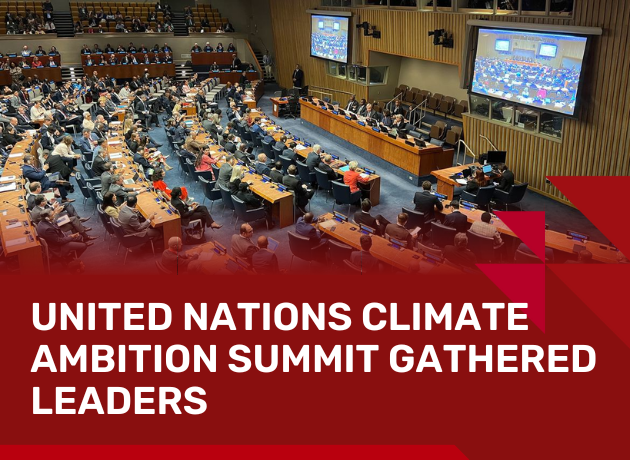
Submitted by elifsena.yaman on October 19, 2023
United Nations Climate Ambition Summit
On September 20, 2023, at the United Nations Headquarters in New York, the Climate Ambition Summit gathered leaders from diverse sectors to highlight tangible, practical steps for global decarbonization and climate justice. The summit brings together those who have already initiated concrete actions, policies, and plans, going beyond mere pledges to fast-track the decarbonization of the global economy. The central objective is to provide compelling evidence that ambitious, pragmatic efforts to reduce emissions and promote climate justice are not only feasible but also set a remarkable example to inspire others to take similar strides.
A Key Moment for Businesses, Cities and Financial Institutions to Call for Increased Accountability of Commitments and Action
As a summit designed to bar entry to “back-sliders, greenwashers, and blame-shifters,” governments are requested to come to the table with increased ambition. Non-state actors are expected to demonstrate the credibility of their commitments and actions and a commitment to a just transition. These efforts are aimed to accelerate urgent implementation for deep and rapid decarbonization across high-emitting sectors and increase flows of finance towards credible implementation.
The time for ambition and action is now
We have less than seven years to halve global greenhouse gas emissions, while completely halting and reversing nature and biodiversity loss. In this pivotal decade, a baseline for science-led action in the real economy is essential, as is how we track and assess progress of action against commitments. Increased transparency is a critical element of enhancing ambition and building accountability.
Transparency is the cornerstone of accountability
Accountability is organizations taking responsibility for the consequences of their environmental actions against expectations and commitments, in line with the latest science. This is critical for effective progress against global environmental goals and targets, while avoiding greenwashing.
Transparency is foundational to create an enabling environment for accountability. For CDP, three key elements pave the way towards accountability: the transparency of risks, opportunities, dependencies and impacts on both people and planet; transparency of commitments and pledges; and tracking progress and oversight of these actions. Environmental-related reporting should be seen as a floor, not a ceiling. Disclosure via CDP remains vital for corporate and subnational stakeholders to ensure global standardization, comparability and consistency of information reflecting the highest ambition, quality, and best practice.
Three essential interventions for accountability
Ahead of the Climate Ambition Summit, CDP calls upon businesses, cities, and financial institutions to support three critical interventions towards building a truly global, fit-for-purpose accountability system.
1. Set and/or enhance with urgency 1.5°c-aligned transition plans
Governments need to set clear expectations on the disclosure of climate, water and nature transition plans. CDP analysis shows that, while 22% of organizations disclosing via CDP have already developed a 1.5°C-aligned transition plan, less than 1% of organizations globally report with sufficient detail to constitute a credible transition plan.
2. Urge policy makers and financial markets regulators to embrace principles of high-quality mandatory disclosure in implementing policy and regulation
Over the past decade, many jurisdictions have introduced disclosure requirements for corporates and FIs that are evolving into broader environmental realms, mirroring the growing consensus of the interconnectedness of climate and broader environmental crises. Although climate-related reporting is mainstream, in large part due to the impetus of the TCFD and ISSB, only 40% of G20 members have introduced water-related disclosure requirements, and only Brazil, the EU and Indonesia require some form of biodiversity-related reporting.
To accelerate the road to regulation, CDP has launched 10 guiding principles for high quality mandatory disclosure (‘HQMD principles’) that support policymakers and financial market regulators in designing comprehensive and effective mandatory environmental disclosure regimes.
While set for environmental disclosure, the HQMD principles can be adapted to broader sustainability disclosure policy and regulation, enhancing transparency, enabling better risk management and driving the economy towards the global environmental goals, including the Paris Agreement. We urge non-state actors to support CDP’s 10 HQMD principles, which also serve to accelerate implementation of the UN HLEG recommendations.
3. Demand an inclusive, evidence-focused and purpose-driven Global Stocktake that recognizes the pivotal role of non-state actors in its deliverance
At COP26, the role of non-state actors was formally recognized in achieving the goals of the Paris Agreement. We already know that we are not on track to achieving these goals collectively: the Synthesis Report of the GST Technical Dialogue noted at COP27 the expected global temperature rise was 2.4–2.6 °C. The GST is a vital mechanism for assessing progress against the collective Paris Agreement goals.
Most importantly, the GST can provide a roadmap for raising ambition and enhancing the implementation of actions of both governments and non-state actors, giving steer to international legal instruments, policies, and actions for course correction and aligning financial flows towards more sustainable activity beyond mitigation.
However, to be effective, it is critical that the GST remains ambitious through being inclusive, evidence-based and purpose-driven. The critical role of transparency was underscored during the GST technical dialogues in Bonn, including in the development of standards, reporting requirements and methodologies and guidance, supporting broader efforts to coalesce around common baselines for action.





